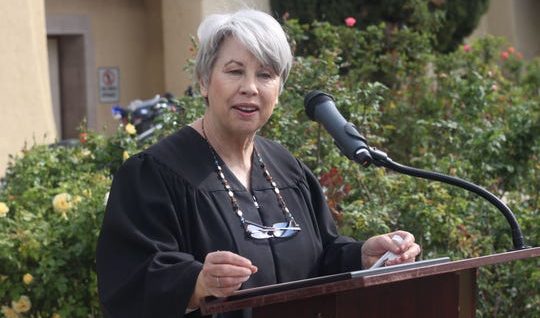
Carlsbad Current-Argus
Fifth Judicial District Court Judge Jane Schuler Gray, who hears many child abuse cases, said the courts continue to serve as an advocate for abused children in Eddy County. Gray was one of many speakers April 6 at the county’s annual walk to protest child abuse.
People in southeast New Mexico find it hard to live with the oil boom, but folks across the state can’t live without it. While Carlsbad and Artesia have higher rents and congested roads, the influx of revenue pumps money into state coffers that is dispersed to early childhood program reforms and raises for teachers as well as highway repairs and new road construction.
New Mexico, home to a chunk of the Permian Basin, recently became the third largest oil producer in the country, behind only Texas and North Dakota. But there are abnormal costs from becoming a global oil producer, and not just quality of life changes for the longtime residents of Eddy County, where rural highways have become death traps due to the fleet of semitrucks rumbling up and down U.S. Highway 285.
At-risk children and foster youth have been negatively impacted by oil production. Over the last two years, the New Mexico Children, Youth, and Families Department (CYFD) in Eddy County has been called more often to investigate allegations of child abuse and neglect. “With more people living here, there have been more referrals and more kids in foster care,” said Maria Calderon, who works at the Carlsbad and Artesia regional offices of CYFD.
“Some of these families that relocate to Eddy County don’t have a support system. They’re alone in the community. It’s really difficult because we believe that family support can be a lifesaver for some of these kids and families,” she said.
The oil surge doesn’t bode well for a state with a sordid track record of keeping kids safe and flourishing. In 2017 and 2018, the Annie E. Casey Foundation Kids Count report ranked New Mexico at the bottom of the country for overall child well-being.
CYFD, the state’s child protective services organization headquartered in Santa Fe, endeavors to keep New Mexico’s kids insulated from abuse and neglect. A 2017 report by the Children’s Bureau of the U.S. Department of Health and Human Services shows that the state’s child abuse statistics started climbing in 2014 before hitting a record high of 25 kids per 1,000 children in 2017, a rate that’s nearly twice the national average.
As a whole, CYFD has had a hard time recruiting and holding onto caseworkers due to low salaries and an overwhelming number of cases. The oil windfall has amplified these challenges for CYFD and for youth in care in Eddy County, Calderon said.
[Related: New Mexicans See Foster Care Challenges, But Are Encouraged by Changes]
[Related: In Santa Fe, NM, ‘We’re Not Going to Play the Blame Game’]
[Related: Lack of Affordable Housing, Enough Foster Families Hurt Taos, NM, Area]
[Related: Provider In Las Cruces, NM, Left Stretched Thin After 2013 Ruling]
“It has gotten worse in the last two years, not only for my employees but also for my clients to be able to afford an apartment, a house, anything like that. Low-income housing is not as available to my clients,” Calderon said. It’s not uncommon to find a landlord charging $1,200 for a decrepit shack, she said. It’s an astronomical rate for a county whose median gross rent from 2013 to 2017 came out to $841, according to U.S. Census Bureau data.
“I struggle filling my vacancies and retaining employees because it’s really hard to survive with the type of salary that CYFD pays to its workers, who come to us as new graduates from university,” she said. “The oil field companies are hiring individuals to do clerical and human resources work. Some of my workers have left to do that kind of work because of the higher pay. Otherwise, they can’t survive in Carlsbad or Artesia.
Some of her employees commute about 75 miles from Roswell, where it’s cheaper to live and easier to find housing (and likely on the “Death Highway,” as locals call it).
A complicating factor is the absence of behavioral health services for children and adults in the area. In 2013, then-Gov. Susana Martinez erroneously claimed that 15 of the state’s private mental health providers were overbilling Medicaid and promptly shut down their Medicaid subsidies, which was the main source of funding for these agencies. After three years, the state Attorney General Office’s cleared all 15 providers of fraud, but not before several of these critical services folded operations.
In Eddy County, which lacks a group home, there’s a gaping hole for at-risk children and adults for mental health therapy.
“We also don’t have treatment foster care agencies so if our children need a higher level of care in foster care, we have to go out of the county” and to places like Roswell, Tumcumcari, Clovis, Albuquerque, Rio Rancho and Los Lunas, Calderon said. “Behavioral services in Eddy County are outpatient services, but we have a waiting list, so we have to be very creative as far as getting out of Eddy County for that.”
Because of the void of critical services for youth in care and vulnerable adults, Calderon says that CYFD has established important bonds with county providers Hope Center, Golden Services Home Health, Cavern City Child Advocacy Center, and Carlsbad Transitional Housing in order to help as many at-risk children and families as possible.
“We’ve been very fortunate in that we’ve created some good working relationships with our community,” said Calderon. “We’ve had to because we’re all facing the same struggles.”
This story is part of a Youth Today project on foster care in New Mexico. It’s made possible in part by the May and Stanley Smith Charitable Trust. Youth Today is solely responsible for the content and maintains editorial independence.





























